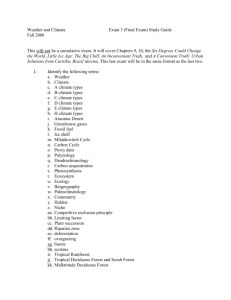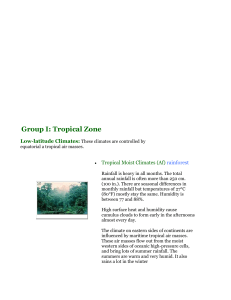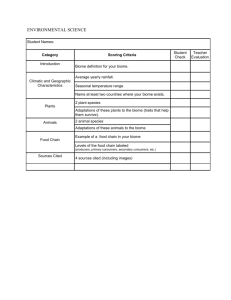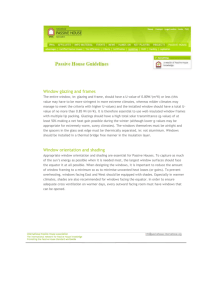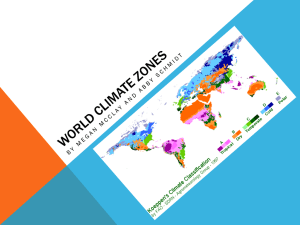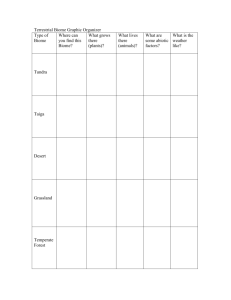Three Basic Climate Groups
advertisement
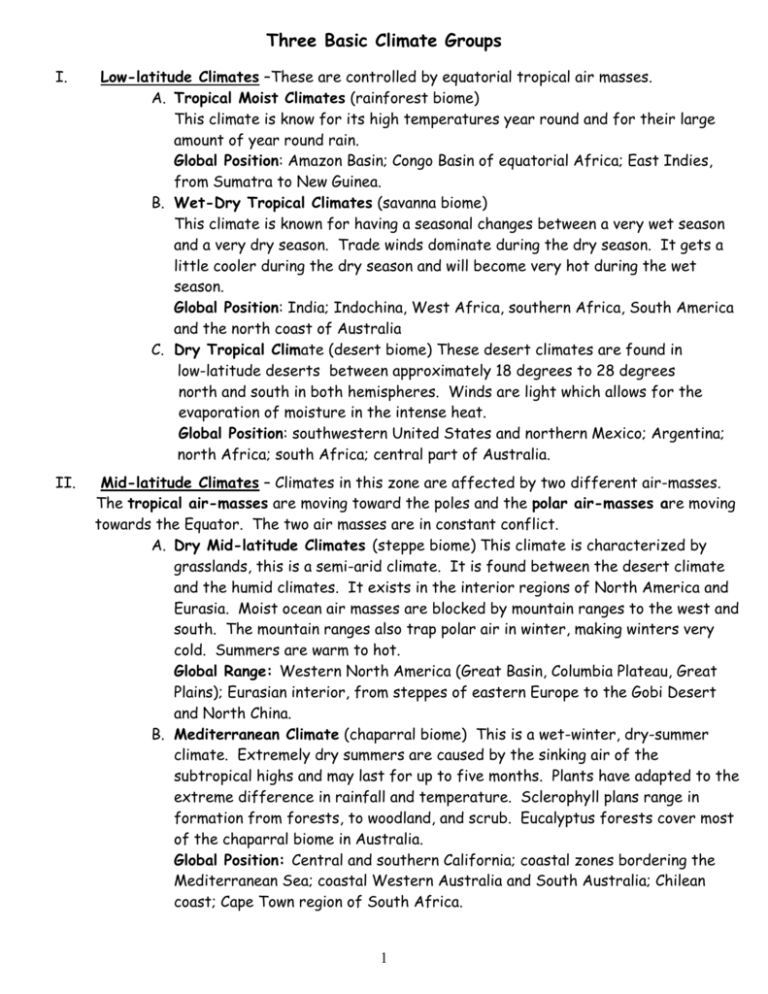
Three Basic Climate Groups I. Low-latitude Climates –These are controlled by equatorial tropical air masses. A. Tropical Moist Climates (rainforest biome) This climate is know for its high temperatures year round and for their large amount of year round rain. Global Position: Amazon Basin; Congo Basin of equatorial Africa; East Indies, from Sumatra to New Guinea. B. Wet-Dry Tropical Climates (savanna biome) This climate is known for having a seasonal changes between a very wet season and a very dry season. Trade winds dominate during the dry season. It gets a little cooler during the dry season and will become very hot during the wet season. Global Position: India; Indochina, West Africa, southern Africa, South America and the north coast of Australia C. Dry Tropical Climate (desert biome) These desert climates are found in low-latitude deserts between approximately 18 degrees to 28 degrees north and south in both hemispheres. Winds are light which allows for the evaporation of moisture in the intense heat. Global Position: southwestern United States and northern Mexico; Argentina; north Africa; south Africa; central part of Australia. II. Mid-latitude Climates – Climates in this zone are affected by two different air-masses. The tropical air-masses are moving toward the poles and the polar air-masses are moving towards the Equator. The two air masses are in constant conflict. A. Dry Mid-latitude Climates (steppe biome) This climate is characterized by grasslands, this is a semi-arid climate. It is found between the desert climate and the humid climates. It exists in the interior regions of North America and Eurasia. Moist ocean air masses are blocked by mountain ranges to the west and south. The mountain ranges also trap polar air in winter, making winters very cold. Summers are warm to hot. Global Range: Western North America (Great Basin, Columbia Plateau, Great Plains); Eurasian interior, from steppes of eastern Europe to the Gobi Desert and North China. B. Mediterranean Climate (chaparral biome) This is a wet-winter, dry-summer climate. Extremely dry summers are caused by the sinking air of the subtropical highs and may last for up to five months. Plants have adapted to the extreme difference in rainfall and temperature. Sclerophyll plans range in formation from forests, to woodland, and scrub. Eucalyptus forests cover most of the chaparral biome in Australia. Global Position: Central and southern California; coastal zones bordering the Mediterranean Sea; coastal Western Australia and South Australia; Chilean coast; Cape Town region of South Africa. 1 Mid-latitude Climates – Continued C. Dry Mid-latitude Climates (grassland biome) These dry climates are limited to the interiors of North America and Eurasia. Ocean air masses are blocked by mountain ranges to the west and south. This allows polar air masses to dominate in winter months. In the summer, a local continental air mass is dominant. A small amount of rain falls during this season. Global Position: western North America (Great Basin, Columbia Plateau, Great Plains; Eurasian interior. D. Moist Continental Climate (AKA Humid Continental) (deciduous forest biome) This climate is known for its seasonal changes between summer and winter are very large. Abundant precipitation falls throughout the year. It is increased in the summer season by tropical air masses. Cold winters are caused by polar and arctic air masses moving south. Global Position: eastern parts of the United States and southern Canada; northern China; Korea; Japan; central and eastern Europe. III. High-latitude Climates – Polar and arctic air masses dominate these regions. Canada and Siberia are two air-mass sources which fall into this group. They met around the 60th and 70th parallels. The Southern Hemisphere does not have any air masses like these. A. Boreal forest Climate (taiga biome) This is a continental climate with long, very cold winter, and short, cool summers. This climate is found in the polar air mass region. This temperature range in this area is larger than in any other climate. Precipitation increases during the summer months, although annual precipitation is still small. Global Position: central and western Alaska; Canada, from the Yukon Territory to Labrador; Eurasia, from northern Europe across all of Siberia to the Pacific Ocean. B. Tundra Climate (tundra biome) The tundra climate is found along arctic coastal areas. The winter season is long and severe. A short, mild season exists, but not a true summer season. Moderating Ocean winds keep the temperatures from being as severe as interior regions. Global Position: arctic zone of North America; Hudson Bay region; Greenland coast; northern Siberia bordering the Arctic Ocean. C. Highland Climate (alpine biome) The highland climates are cool to cold, found in mountains and high plateaus. Climates change rapidly on mountains, becoming colder the higher the altitude gets. The climate of the highland area is closely related to the climate of the surrounding biome. The highlands have the same seasons and wet and dry periods as the biome they are in. The mountain climates are very important to mid-latitude biomes. They work as water storage areas. Snow is kept back until spring and summer when it is released slowly as water through melting. Global Position: Rocky Mountain Range in North America; the Andean mountain range in South America; the Alps in Europe; Mt. Kilimanjaro in Africa; the Himalayans in Tibet; Mt. Fuji in Japan. 2

